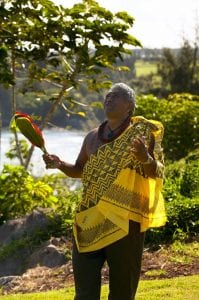Instagram and Google Maps Contribute to Hawaii Tourists Behaving Badly

Skift Take
In Hawaii, visitor behavior driven by the desire for Instagram-worthy photos as well as the greater ease of finding once little-known locations through Google Maps is leading to congestion and degradation of some of the state's most remote and sacred natural areas.
In what might seem an ironic twist, some observers also say the fact that hiking and other adventure-oriented activities have overtaken golf as a preferred visitor activity is exacerbating the problem.
“The visitor of 20 years ago is very different than what we have today,” said Sue Kanoho, executive director of the Kauai Visitors Bureau. “With the whole Instagram thing, people want the beauty shot in the remote location. They are often not aware of what they are doing and often will not listen to advice from local people. There have been some nasty exchanges when residents try to help, but just get told off.”
For Hawaii, tourism is both its biggest asset and largest problem. Although tourism is by far the state’s major economic driver, it’s also a growing threat to some of its most scenic areas and an increasing source of frustration to those who live there.
While Hawaii is hardly the only destination facing overtourism and other sustainability issues, its isolated location, Native Hawaiian heritage and fragile island ecosystem make the challenges especially acute. For tourism marketers, as well as for travel advisors and suppliers, selling Hawaii has become a more nuanced process.
Impact on Kauai
Congestion in once-pristine areas and conflicts between residents and tourists are especially acute in Kauai’s wild and rugged northwest corner. Here stringent measures were recently enacted to limit and regulate visitor and car access to Haena State Park, the gateway to trails along the Napali Coast, a spectacular roadless region of tropical rainforests, Native Hawaiian sacred sites, hidden beaches and jaw-dropping views.
Along with environmental issues, Kanoho said worsening visitor behavior is leading to more safety problems. She cited a rise in the number of emergency rescues on hiking trails and incidents where tourists have been bitten when ignoring posted warnings about getting close to endangered monk seals on beaches.
Kauai is pushing harder with visitor education, including encouraging travel advisors to counsel clients about responsible behavior and safety issues, Kanoho said.
“For example, we want people to understand flash-flooding conditions and why hiking with a tour guide who knows the area and can educate you is the best way to go,” she said. “Travel agents can be our frontline support and we’re doing webinars that emphasize this.”
Kanoho likened the formerly pleasant visitor experience in Haena State Park to a "zoo."
“We had 2,500 people heading there every day and cars were parked everywhere," she said. "Now it’s limited to 900 visitors a day and they need a reservation to park. We also have a new shuttle that drops people off for a $15 fare.”
In other measures, Kauai, which recently adopted a new strategic plan for tourism management, is also looking at ways to limit car traffic and raise more money for the management of parklands and wildness areas.
“Our strategic plan is a bold move in that it takes into account quality of life for our local residents,” Kanoho said. “We’re looking at more shuttles and a stronger presence with Uber and Lyft to cut down on car rental. We’ve also started charging for parking in places like Waimea Canyon so we can put more money back into park infrastructure.”
Visitation Up, Spending Down
The challenges facing Kauai are also being felt across the state, especially in densely populated Oahu where sites such as Hanauma Bay, a popular snorkeling site, and the Diamond Head trail are magnets for visitor congestion.
“The problem is that there are too many people and not enough places for them to engage in recreational activity,” said Paul Brewbaker, a Honolulu-based economist and co-author of “Charting a New Course for Hawaii Tourism,” a report released by the University of Hawaii’s Economic Research Organization last year.
Among the challenges detailed in the report is that changes in visitor activity preferences, most notably a dramatic shift from golf to hiking, have contributed to sharply declining visitor spending. The report noted that although Hawaii received 2.8 million more visitors in 2017 than in 1989, their expenditures (adjusted for inflation) were $1.1 billion less in 2017 than in 1989.
Brewbaker told Skift that he believes the most likely solution for both minimizing visitor congestion and boosting revenue can come through innovations in smart phone technology. Charging for access to areas that are now free is also necessary, he said.
“Apps could enable the Hawaii Department of Land and Natural Resources to set up charges for visiting places at high-demand times, similar to what Uber does,” he said. “If more people want to visit the top of Mt. Haleakala at sunrise than parking can accommodate, regulate it and use pricing. We need to impose an external cost to get better governance.”
Changes at the Top
The need to balance tourism promotion with environmental and community concerns has led to recent reorganization and changes in branding and messaging at the Hawaii Tourism Authority, which oversees tourism promotion in the state.
One of the indicators that a new approach was needed came from the organization’s own 2018 survey of state residents, two-thirds of whom agreed with the statement that Hawaii is “being run for tourists at the expense of local people.” While 78 percent of residents in 2009 agreed that “tourism has brought more benefits than problems,” only 59 percent did so in 2018.
Chris Tatum, a former Marriott executive who just completed his first year as president and CEO of the Hawaii Tourism Authority, told Skift that addressing the concerns of locals, along with encouraging responsible tourism, are now stronger priorities.
“Last year I took a look at the organization, recognizing that tourism is Hawaii’s economic driver,” he said. “Much as local people get frustrated with it, it funds our parks, schools and roads. But we have to do things in the right way.”
While the organization formerly focused only on marketing, it now also oversees departments devoted to Hawaiian culture, natural resources and community engagement.
Also new is the Kuleana Campaign, a series of 23 short videos designed to educate visitors. Shown on airplanes and in airports and hotel rooms, the video topics include Hawaiian history, cultural traditions, protecting coral reefs and responsible practices on beaches and hiking trails.
“The idea is that most visitors really want to do the right thing, but you have to share with them what that is,” Tatum said. “Part of the message is how important the land is to us here. You’d be surprised at how many people are clueless about this.”
Among locals who think the video campaign is much needed is Ken Kimi, owner of Honolulu-based Touch Above Travel and president of the American Society of Travel Advisors' Hawaii chapter. He views them as necessary for both public safety and environmental protection.
"We have many drownings, most of them are tourists who want the 'selfie' and enter places that say 'keep out' or 'high surf,'" Kimi said. "We are also facing a lot of reef damage."
Tatum said he intends the Hawaii Tourism Authority to take a leading role in promoting responsible tourism and plans to make it a part of all future branding efforts. As one measure. the organization recently asked its industry partners to discontinue the use of single-use plastics.
“If they don’t, we won’t promote them,” Tatum said. “We’re also getting all of our contractors around the world—anyone involved in promoting Hawaii—on board with our efforts. Everyone is excited because they know this is important to travelers, especially young people.”
Hawaiian Cultural Advisor Input
Appropriately enough, some of the push for greater environmental and cultural sensitivity is coming from the growing number of Native Hawaiian cultural advisors working in the tourism industry.
Among them is Clifford Nae’ole, a former president of the Native Hawaiian Hospitality Association who has been cultural advisor at Maui’s Ritz-Carlton Kapalua for 28 years. Over that time he’s seen an evolving role for himself and other cultural advisors.
“At first hotels were hiring cultural advisors mainly to teach guests to make leis or play the ukulele, but we’ve become a necessity for interpreting and protecting Hawaiian culture,” he said. “Hawaiians are deeply concerned about what’s happening—we know that the land and water and beaches are finite. Now our patience is finite. We fear becoming strangers in our own land.”
Nae'ole is currently working with other cultural advisors to develop a AAA Diamond Awards-style system for hotels throughout the state that would evaluate properties based on how much they reflect Hawaiian culture in everything from décor and cuisine to their support of local charities and communities.
“We’re brainstorming about ways that we can not only evaluate hotels, but provide them with training on how they can do a better job of exemplifying Hawaii,” he said. “Guests want these kinds of authentic experiences, so it’s a way of balancing the need to preserving our culture while also being commercially successful.”
Aloha Spirit
Any efforts to protect Hawaii’s unique heritage and natural environment is welcomed by Lena Brown, a travel advisor with Largay Travel in Las Vegas who does a brisk business in sending clients to the state.
“A lot of our clients choose Hawaii specifically because of its culture and the local people—you really do feel the aloha spirit when you are there,” she said. “Hawaiians are passionate about their homeland and they want to instill this in the tourist.”
Brown said she tries to encourage responsible tourism by encouraging clients to respect hiking trails and furnishes them with litter bags to pick up any trash along the way.
“I also encourage them to visit culture sites like the Bishop Museum, which has fantastic exhibits on Native Hawaiian history and culture,” she said. “These sites should be promoted a lot more than they are.”





